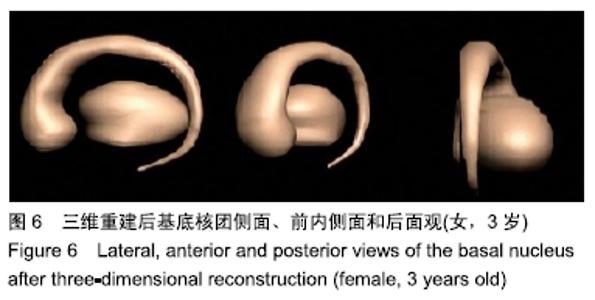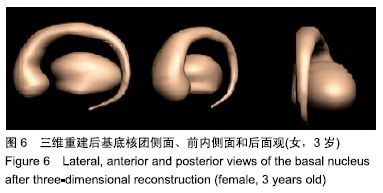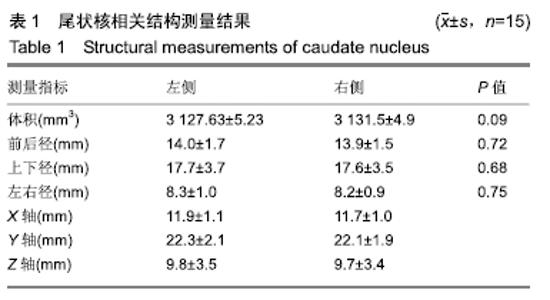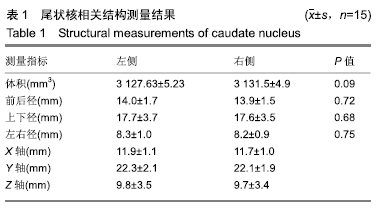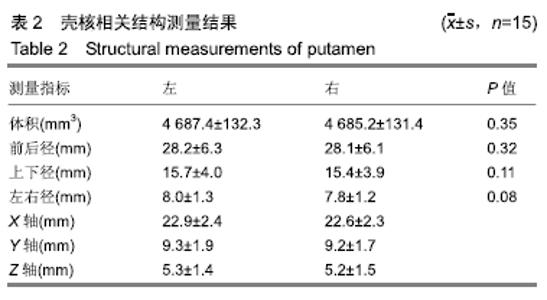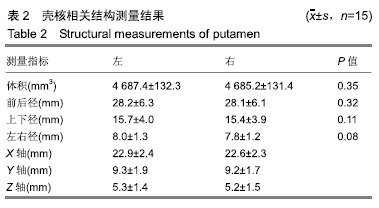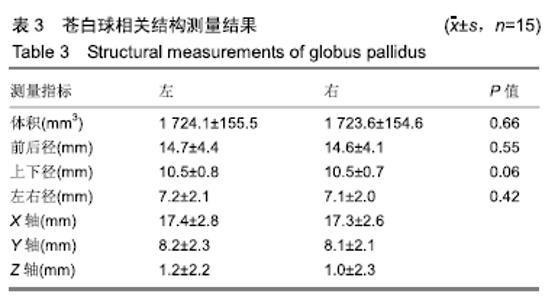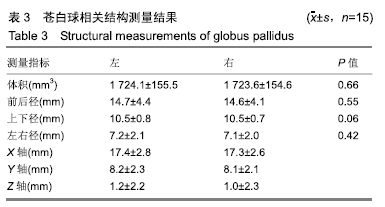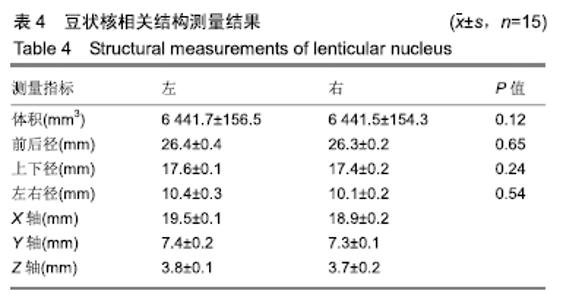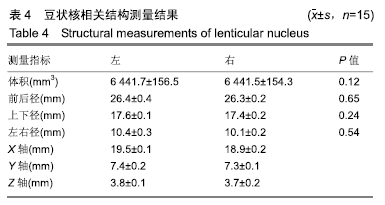[1] 封洲燕,郭哲杉,王兆祥.深部脑刺激作用机制的研究进展[J].生物化学与生物物理进展,2018,45(12):1197-1203.
[2] DOUGHERTY DD. Will Deep Brain Stimulation Help Move Precision Medicine to the Clinic in Psychiatry?. Biol Psychiatry.2019;85(9): 706-707.
[3] VOON V.Toward Precision Medicine: Prediction of Deep Brain Stimulation Targets of the Ventral Internal Capsule for Obsessive- Compulsive Disorder.Biol Psychiatry.2019;85(9): 708-710.
[4] NELSON AB, KREITZER AC.Reassessing Models of Basal Ganglia Function and Dysfunction.Annu Rev Neurosci. 2014;37:117-135.
[5] NARVACAN K, TREIT S, CAMICIOLI R, et al.Evolution of deep gray matter volume across the human lifespan. Human brain mapping. 2017;38(8): 3771-3790.
[6] CHEONG JLY, ANDERSON PJ, ROBERTS G, et al. Contribution of brain size to IQ and educational underperformance in extremely preterm adolescents.PloS One.2013;8(10): e77475-e77482.
[7] SETÄNEN S, LEHTONEN L, PARKKOLA R, et al.Prediction of neuromotor outcome in infants born preterm at 11 years of age using volumetric neonatal magnetic resonance imaging and neurological examinations. Dev Med Child Neurol. 2016;58(7):721-727.
[8] CATANI M, DELL’ACQUA F, DE SCHOTTEN MT.A revised limbic system model for memory, emotion and behaviour. Neurosci Biobehav Rev. 2013;37(8):1724-1737.
[9] YOUNG JM, POWELL TL, MORGAN BR, et al.Deep grey matter growth predicts neurodevelopmental outcomes in very preterm children.Neuroimage.2015;111(5): 360-368.
[10] LIM SJ, FIEZ JA, HOLT LL.Role of the striatum in incidental learning of sound categories. Proc Natl Acad Sci U S A. 2019. pii: 201811992.
[11] NAKAGAWA S,TAKEUCHI H,TAKI Y,et al.Basal ganglia correlates of fatigue in young adults. Scientific reports.2016;6(12): 21386-21393.
[12] MORENO-ALCÁZAR A, RAMOS-QUIROGA JA, RADUA J, et al.Brain abnormalities in adults with Attention Deficit Hyperactivity Disorder revealed by voxel-based morphometry. Psychiatry Res Neuroimaging. 2016;254(7): 41-47.
[13] VAN ERP TGM, HIBAR DP, RASMUSSEN JM, et al. Subcortical brain volume abnormalities in 2028 individuals with schizophrenia and 2540 healthy controls via the ENIGMA consortium. Mol psychiatry.2016; 21(4): 547-553.
[14] QIU T, CHANG C, LI Y, et al.Two years changes in the development of caudate nucleus are involved in restricted repetitive behaviors in 2–5-year-old children with autism spectrum disorder.Dev Cogn Neurosci. 2016;19:137-143.
[15] 武巧荣.倒退型ASD儿童的临床特征及其脑体积研究[D].南京:南京医科大学,2017.
[16] GAUTAM P, LEBEL C, NARR KL, et al.Volume changes and brain-behavior relationships in white matter and subcortical gray matter in children with prenatal alcohol exposure. Human Brain Mapping.2015; 36(6):2318-2329.
[17] MERZ EMILY C, MASKUS ELAINE A, MELVIN SAMANTHA A, et al. Parental punitive discipline and children's depressive symptoms: Associations with striatal volume.Dev Psychobiol.2019;9(3):1-8.
[18] WANG ML, WEI XE, FU JL, et al. Subcortical nuclei in Alzheimer’s disease: a volumetric and diffusion kurtosis imaging study.Acta Radiologica.2018; 59(11): 1365-1371.
[19] YI HA, MÖLLER C, DIELEMAN N, et al.Relation between subcortical grey matter atrophy and conversion from mild cognitive impairment to Alzheimer's disease. J Neurol Neurosurg Psychiatry.2016;87(4): 425-432.
[20] 张伟忠,卢凤飞,薛杉,等.帕金森患者丘脑底核三维重建[J].转化医学电子杂志,2016,3(3):5-8.
[21] 刘桂雪,史勇红,王士卿,等.基于磁共振T1成像的帕金森病相关脑结构体积差异性分析[J].解剖学报,2018,49(3):347-354.
[22] KOCAMAN H. Evaluation of intracerebral ventricles volume of patients with Parkinson's disease using the atlas-based method:a methodological study.J Chem Neuroanat. 2019;98:124-130.
[23] ELKATTAN A, MAHDY A, ELTOMEY M, et al.A Study of volumetric variations of basal nuclei in the normal human brain by magnetic resonance imaging. Clin Anat.2017;30(2): 175-182.
[24] 吴成君,曹一翀,马雪霞,等.极早产儿和/或极低出生体重儿对青少年时脑体积影响的Meta分析[J].中国循证儿科杂志,2017,12(6):423-428.
[25] RHEIN C, MÜHLE C, RICHTER-SCHMIDINGER T, et al. Neuroanatomical correlates of intelligence in healthy young adults: the role of basal ganglia volume.PloS one.2014;9(4): e93623-e93630.
[26] LOH WY, ANDERSON PJ, CHEONG JLY, et al.Longitudinal growth of the basal ganglia and thalamus in very preterm children.Brain Imaging and Behavior.2019;16(3):1-14.
[27] NARVACAN KARL, TREIT SARAH, CAMICIOLI RICHARD, et al. Evolution of deep gray matter volume across the human lifespan.Hum Brain Mapp, 2017, 38(2): 3771-3790.
[28] SORIANO-MAS C, HARRISON BJ, PUJOL J, et al. Structural covariance of the neostriatum with regional gray matter volumes.Brain Struct Funct. 2013;218(3):697-709.
[29] GODDINGS AL, MILLS KL, CLASEN LS, et al.The influence of puberty on subcortical brain development. Neuroimage.2014; 88(3): 242-251.
[30] RAZNAHAN A, SHAW PW, LERCH JP, et al. Longitudinal four- dimensional mapping of subcortical anatomy in human development. Proc Natl Acad Sci U S A.2014;111(4):1592-1597.
[31] GODDINGS AL, MILLS KL, CLASEN LS, et al. The influence of puberty on subcortical brain development. Neuroimage.2014;88(3): 242-251.
[32] WIERENGA L, LANGEN M, AMBROSINO S, et al. Typical development of basal ganglia, hippocampus, amygdala and cerebellum from age 7 to 24.Neuroimage.2014;96(4):67-72.
[33] PIETSCHNIG J, PENKE L, WICHERTS JM, et al.Meta-analysis of associations between human brain volume and intelligence differences: How strong are they and what do they mean?.Neurosci Biobehav Rev. 2015;57:411-432.
[34] QIU A, CROCETTI D, ADLER M, et al. Basal ganglia volume and shape in children with attention deficit hyperactivity disorder.Am J Psychiatry. 2009;166(1):74-82.
[35] LIN HY, NI HC, LAI MC, et al.Regional brain volume differences between males with and without autism spectrum disorder are highly age-dependent.Mol Autism.2015;6:29.
|
